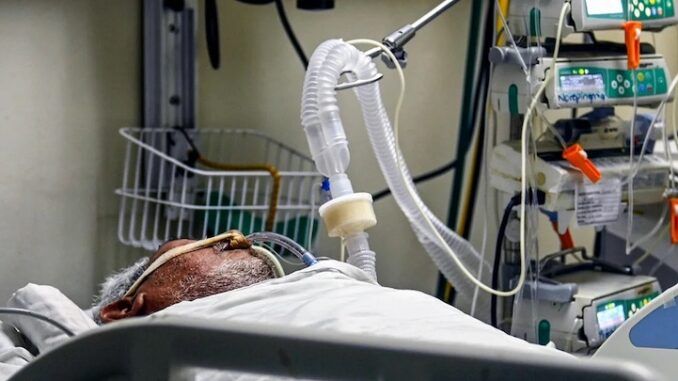
Nearly all COVID-19 patients who died in hospital during the early phase of the pandemic were killed as a direct result of being put on a ventilator, a disturbing new report has concluded.
A new analysis suggests that most patients who were forced to be hooked up to a ventilator due to a COVID-19 infection also developed secondary bacterial pneumonia. This pneumonia was responsible for a higher mortality rate than the COVID-19 infection.
So while COVID-19 may have put these patients in the hospital, it was actually a secondary infection brought on by the use of a mechanical ventilator that caused their deaths.

BYPASS THE CENSORS
Sign up to get unfiltered news delivered straight to your inbox.
You can unsubscribe any time. By subscribing you agree to our Terms of Use
“Our study highlights the importance of preventing, looking for, and aggressively treating secondary bacterial pneumonia in critically ill patients with severe pneumonia, including those with COVID-19,” says Benjamin Singer, a pulmonologist at Northwestern University in Illinois.
Sciencealert.com reports: The team looked at records for 585 people admitted to the intensive care unit (ICU) at Northwestern Memorial Hospital, also in Illinois. They all had severe pneumonia and/or respiratory failure, and 190 had COVID-19.
Using a machine learning approach to crunch through the data, the researchers grouped patients based on their condition and the amount of time they spent in intensive care.
The findings refute the idea that a cytokine storm following COVID-19 – an overwhelming inflammation response causing organ failure – was responsible for a significant number of deaths. There was no evidence of multi-organ failure in the patients studied.

Instead, COVID-19 patients were more likely to develop ventilator-associated pneumonia (VAP) and for longer periods. Cases where VAP didn’t respond to treatment were significant in terms of the overall mortality rates in the study.
“Those who were cured of their secondary pneumonia were likely to live, while those whose pneumonia did not resolve were more likely to die,” says Singer.
“Our data suggested that the mortality related to the virus itself is relatively low, but other things that happen during the ICU stay, like secondary bacterial pneumonia, offset that.”
These results suggest that ICU outcomes could be improved if there were better strategies to diagnose and treat VAP episodes – something that the researchers say needs to be addressed in the future.
It’s worth bearing in mind that if a patient’s requirement for a ventilator to treat COVID-19 complications leads to VAP, this doesn’t imply that a COVID-19 infection is less dangerous, nor does it decrease the number of COVID-19 fatalities.
As the authors write in their paper, “The relatively long length of stay among patients with COVID-19 is primarily due to prolonged respiratory failure, placing them at higher risk of VAP.”
But the findings highlight a need for further study and to be cautious when making assumptions about the cause of death in COVID-19 cases. A detailed molecular analysis from the same study should reveal more about what makes the difference between recovering or not from VAP.
It’s also another example of how machine learning artificial intelligence can process vast amounts of data and spot patterns beyond us mere humans – whether it’s analyzing proteins or advancing mathematics.
“The application of machine learning and artificial intelligence to clinical data can be used to develop better ways to treat diseases like COVID-19 and to assist ICU physicians managing these patients,” says Catherine Gao, also a pulmonologist at Northwestern.
The research has been published in the Journal of Clinical Investigation.


There s nothing new about it New York nurses were on the Internet saying straight out that they were being ordered to kill patients using the ventilators. By the government.
ridiculous.
Most idiotic comment yet. I’m sure you’ll top that with your reply.
This wasn’t ever in doubt among those who actually did follow the relevant science.
Covid-19 is a form of viral pneumonia
and no one gets put on a ventilator.
It depends on your how much oxygen in your blood if it’s below 88% and you have a liter or more of fluid in a lung Yes you would be a candidate.
A candidate gets oxygen first.they don’t need a ventilator.
Are you that dumb? These are critically ill patients.
When they’re unable to maintain oxygen saturation AFTER maximum oxygen, BiPap, etc., intubation is the last hope.
are you that stupid. a ventilator BREATHES for the patient ,meaning the patient is unable to breathe on their own. BIPAP? lol lol you have no clue to wtf you are talking about. nothing to do with o0xygen saturation. lol by the way hospitals have few ventilators. contrary to the horror fantasies you read.
Any worthy ICU will have ventilators available. I have no idea where you’re getting this idea that mechanical ventilation is rare. Several of my patients are currently intubated and being ventilated in the ICU.
The indication for escalating respiratory support is, yes, oxygen saturation. If someone has an o2sat of 100%, there are very few reasons to intubate them. But yeah, if someone’s o2sat is dropping and is refractory to o2 support or noninvasive positive pressure vent (bipap), they are getting intubated.
first of all ventilators are rarely used and certainly not for pneumonia. also hospitals have very few ventilators available. this lie was part of the fear porn for the covidiocy hoax.
Let not forget that fauxi mandated remdesivir useage to “fight the infection”. It lowers the oxygen saturation in the blood, hence requiring the ventilators. Both were medical malpractice at the least!